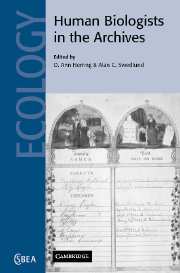 Human Biologists in the Archives
Human Biologists in the Archives Book contents
- Frontmatter
- Contents
- Contributors
- Foreword by Sydel Silverman and Michael A. Little
- Acknowledgements
- 1 Human biologists in the archives: demography, health, nutrition and genetics in historical populations
- 2 The use of archives in the study of microevolution: changing demography and epidemiology in Escazú, Costa Rica
- 3 Anthropometric data and population history
- 4 For everything there is a season: Chumash Indian births, marriages, and deaths at the Alta California missions
- 5 Children of the poor: infant mortality in the Erie County Almshouse during the mid nineteenth century
- 6 Worked to the bone: the biomechanical consequences of ‘labor therapy’ at a nineteenth century asylum
- 7 Monitored growth: anthropometrics and health history records at a private New England middle school, 1935–1960
- 8 Scarlet fever epidemics of the nineteenth century: a case of evolved pathogenic virulence?
- 9 The ecology of a health crisis: Gibraltar and the 1865 cholera epidemic
- 10 War and population composition in Åland, Finland
- 11 Infectious diseases in the historical archives: a modeling approach
- 12 Where were the women?
- 13 Malnutrition among northern peoples of Canada in the 1940s: an ecological and economic disaster
- 14 Archival research in physical anthropology
- Index
- References
9 - The ecology of a health crisis: Gibraltar and the 1865 cholera epidemic
Published online by Cambridge University Press: 12 August 2009
- Frontmatter
- Contents
- Contributors
- Foreword by Sydel Silverman and Michael A. Little
- Acknowledgements
- 1 Human biologists in the archives: demography, health, nutrition and genetics in historical populations
- 2 The use of archives in the study of microevolution: changing demography and epidemiology in Escazú, Costa Rica
- 3 Anthropometric data and population history
- 4 For everything there is a season: Chumash Indian births, marriages, and deaths at the Alta California missions
- 5 Children of the poor: infant mortality in the Erie County Almshouse during the mid nineteenth century
- 6 Worked to the bone: the biomechanical consequences of ‘labor therapy’ at a nineteenth century asylum
- 7 Monitored growth: anthropometrics and health history records at a private New England middle school, 1935–1960
- 8 Scarlet fever epidemics of the nineteenth century: a case of evolved pathogenic virulence?
- 9 The ecology of a health crisis: Gibraltar and the 1865 cholera epidemic
- 10 War and population composition in Åland, Finland
- 11 Infectious diseases in the historical archives: a modeling approach
- 12 Where were the women?
- 13 Malnutrition among northern peoples of Canada in the 1940s: an ecological and economic disaster
- 14 Archival research in physical anthropology
- Index
- References
Summary
Introduction
It was perhaps no exaggeration that nineteenth century Gibraltarians achieved the dubious distinction of being ‘a population, filthy in themselves, and overcrowded, perhaps, beyond any community in the world’ (Hennen 1830: 71). As was the case in many other urban centers of westernized countries, the inhabitants of Gibraltar faced insults from their poor environmental situation and, all too frequently, their daily exposure to infectious diseases. Not surprisingly, poor health and low survivorship were normal by-products of life for all but the very privileged in these urban deathtraps. For Gibraltar, the 1860s captures this dynamic and has been selected here to examine the forces and factors that affected health under a variety of environmentally influenced stressors.
Numerous factors operated to create unhealthy conditions in Gibraltar. Population growth was a particular problem as it had occurred at such an unprecedented rate within an infrastructure that was woefully inadequate to meet its demands. Housing was in limited supply and was further aggravated by the fact that landowners were more concerned with making large and quick profits than with providing proper accommodation for the poor working classes. Aside from the burdens of a growing local population, Gibraltar was also host to a number of itinerant laborers, immigrants, and visitors. As a strategically located free port, Gibraltar proved to be an important node in a trade network linking numerous urban centers throughout Europe, the Mediterranean, Africa and the New World.
- Type
- Chapter
- Information
- Human Biologists in the ArchivesDemography, Health, Nutrition and Genetics in Historical Populations, pp. 178 - 215Publisher: Cambridge University PressPrint publication year: 2002


